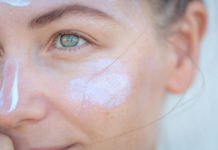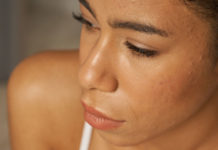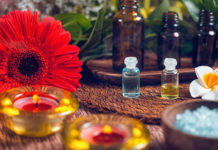
Winter’s cold air, severe climate and indoor heat can wreck havoc on your skin. As temperatures nose-dive, it’s time to adjust your skin care routine. Here are six natural solutions.
By Nancy Ripton
1 | Change up your Moisturizer
The right moisturizer is more important than ever during the harsh months of winter. Natural products add moisture to your skin without any harsh chemicals that can further dry out your pores.
Drier skin types should choose a heavier cream like Dr. Hauschka’s Rose Day Cream. It’s made with natural essential oils such as citronellol, linalool and limonene that will help lock in moisture.
Even oilier skin types need a moisture boost during the winter months. If you find a heavy cream is too much as a daily moisturizer you can use a product like the Rose Day Cream as a mask when you go out in the cold. “It’s like a Canada Goose for your face,” says Enaam Takla, head esthetician with Dr. Hauschka. “When the weather drops below 15 degrees Celsius [or if you’re doing an outdoor sport such as skiing] put a layer of Rose Day Cream on like a coat.”
2 | Lock in Moisture
Always soothe lotion on damp skin. If you wait too long after cleansing, the moisture will start to disappear. The goal of a cream is to lock in moisture. The moisture needs to be there.
3 | Cleanse and Exfoliate
Cleansers are important because they help maintain the pH balance of your skin. “If you don’t clean properly, all the dirt goes inside your skin,” says Takla. The right cleanser can also act as an exfoiliant and remove dead skin cells without any harshness. “I’m against [traditional] exfoliation,” says Takla. “When you scrub, you stretch the muscles. With time this causes your skin to lose elasticity.”
Instead, apply natural cleansing cream to your damp face and neck. Let the cleanser sit on the face for two to five minutes while you shower or brush your teeth. Then make gentle circles with your fingers and move the cleanser downward on the neck without rubbing. “You want to respect the flow of the lymph system and direct all blood and toward heart,” says Takla.
4 | Use a Weekly Mask
A deep clay mask should be used once every week to go deep into your pores and remove dead cells without harsh scrubbing. If your skin is really dry you can apply a mask once every two or three weeks instead.
5 | Choose Natural
“Anything you put on your skin is absorbed through the dermis into the capillaries, blood and circulation,” says Takla. “If you apply a product full of chemicals, those chemicals go directly into your body.”
Currently there are no legal regulations for natural cosmetics in Canada. It’s up to you to go a little deeper than just looking for the word natural or organic. Certifications are one of the best and easiest ways to ensure that your natural products are everything they’re claiming to be.
While there are a lot of different certifications, there are three gold standards: EcoCert, NATRUE and BDIH. All three certifications ensure that your product has no synthetic fragrances, dyes or petroleum-based paraffins and silicon oils. Products bearing these labels use a multitude of natural materials and plant-based surfactants or emulsifiers. They also use no chemical UV filters and no parabens or halogenated substances.
The BDIH logo is for certified natural cosmetics and it aims to create transparency amongst the brands and make things easier for the consumer. If organic is part of the product name, a minimum of 95 per cent of the natural ingredients must be derived from organic production. There can be no more than 10 per cent of transesterified and hydrogenated oils in the product. Also, the check of the formulations is carried out by an independent organization.
NATRUE is an international association located in Brussels. It’s established a worldwide standard for natural and organic cosmetics. At least 95 per cent of the bio-compliant raw materials must be derived from certified organic sources, and at least 70 per cent of the bio-compliant raw materials must come from certified organic sources.
Ecocert predominately certifies food, but also detergents, perfumes, textiles and cosmetics. It fosters eco-friendly agriculture and compliance with the natural cosmetics standards. Although, the certification is still good, just 60 per cent of the products used need to be organic to bear this label.
6 | Pick a Brand you Trust
“People mix products and their skin can’t heal because they’re using so many different things on their face,” says Takla. The products in a skincare line are made to work together. Pick a brand you love and be consistent for the best results. VM
BONUS: You’ll also find that pimple and blackhead occurrences will decrease when you start using organic products on your skin. Natural products can also work wonders with conditions like eczema.
Be Good to Your Skin
Try these natural products to protect and replenish your skin.
Dr. Hauschka Hydrating Mask
Quince seed extract replenishes your skin and helps it retain moisture through the winter months. Nourishing almond, avocado and jojoba oils will hydrate even the driest of skin.
(1 oz. $52.95)
Andalou 1000 Roses ‘Rosewater Mask’
This facemask renews skin cells and revitalizes the skin by offering deep hydration and cellular support. Contains pomegranate, hyaluronic, aloe vera and alpine rose stem cells to soothe and nourish, giving your skin a youthful glow. (1.7 fl oz, $14.95)
MyChelle Dermaceuticals Apple Brightening Cleanser
This gentle sulfate-free cleanser that softens the texture of the skin and diminishes discolouration that’s caused by harmful UVA & UVB sun exposure. Contains mallic acid, polyphenol-rich apple, and daisy extract.
(2.1 fl oz, $14.25)
Aubrey Revitalizing Therapy Moisturizer with Rosa Mosqueta Oil
The replenishing anti-wrinkle formula works overtime to provide healthy, vibrant skin with plenty of moisture. Rosa Mosqueta oil is a nutrient derived from organic rose hip seeds that support the skin while the carnosine and milk thistle gets rid of wrinkles.
(1.7 oz, $22.50)












